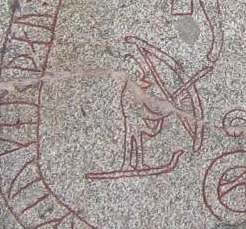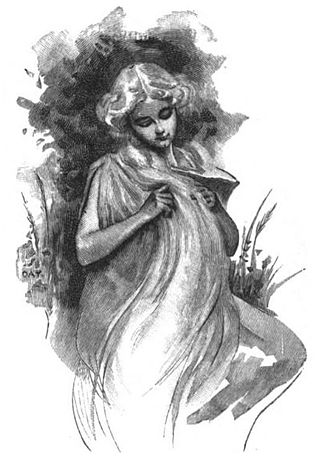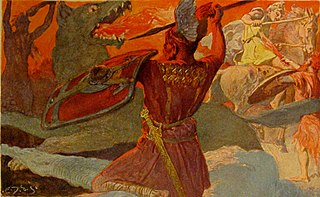"Edda" is an Old Norse term that has been applied by modern scholars to the collective of two Medieval Icelandic literary works: what is now known as the Prose Edda and an older collection of poems now known as the Poetic Edda. The term historically referred only to the Prose Edda, but this usage has fallen out of favour because of confusion with the other work. Both works were written down in Iceland during the 13th century in Icelandic, although they contain material from earlier traditional sources, reaching back into the Viking Age. The books provide the main sources for medieval skaldic tradition in Iceland and for Norse mythology.

In Norse mythology, Heimdall is a god. He is the son of Odin and nine mothers. Heimdall keeps watch for invaders and the onset of Ragnarök from his dwelling Himinbjörg, where the burning rainbow bridge Bifröst meets the sky. He is attested as possessing foreknowledge and keen senses, particularly eyesight and hearing. The god and his possessions are described in enigmatic manners. For example, Heimdall is emerald-toothed, "the head is called his sword," and he is "the whitest of the gods."

In Norse mythology, Ullr is a god associated with skiing. Although literary attestations of Ullr are sparse, evidence including relatively ancient place-name evidence from Scandinavia suggests that he was a major god in earlier Germanic paganism. Proto-Germanic *wulþuz ('glory') appears to have been an important concept of which his name is a reflex. The word appears as owlþu- on the 3rd-century Thorsberg chape.

In Norse mythology, the Vanir are a group of gods associated with fertility, wisdom, and the ability to see the future. The Vanir are one of two groups of gods and are the namesake of the location Vanaheimr. After the Æsir–Vanir War, the Vanir became a subgroup of the Æsir. Subsequently, members of the Vanir are sometimes also referred to as members of the Æsir.

In Norse mythology, Sif is a golden-haired goddess associated with earth. Sif is attested in the Poetic Edda, compiled in the 13th century from earlier traditional sources, and the Prose Edda, written in the 13th century by Snorri Sturluson, and in the poetry of skalds. In both the Poetic Edda and the Prose Edda, she is known for her golden hair and is married to the thunder god Thor.

Mímir or Mim is a figure in Norse mythology, renowned for his knowledge and wisdom, who is beheaded during the Æsir–Vanir War. Afterward, the god Odin carries around Mímir's head and it recites secret knowledge and counsel to him.

In Norse mythology, the Nine Mothers of Heimdallr are nine sisters who gave birth to the god Heimdallr. The Nine Mothers of Heimdallr are attested in the Prose Edda, written in the 13th century by Snorri Sturluson; in the poetry of skalds; and possibly also in a poem in the Poetic Edda, a book of poetry compiled in the 13th century from earlier traditional material. Scholars have debated what being "born of nine mothers" implies and have sought to connect the notion to other European folk motifs. Scholars have theorized that Heimdallr's Nine Mothers may be identical to the Nine Daughters of Ægir and Rán, who personify waves. In turn, Heimdallr would be born of the sea.

Dagr is the divine personification of the day in Norse mythology. He appears in the Poetic Edda, compiled in the 13th century from earlier traditional sources, and the Prose Edda, written in the 13th century by Snorri Sturluson. In both sources, Dagr is stated to be the son of the god Dellingr and is associated with the bright-maned horse Skinfaxi, who "draw[s] day to mankind". Depending on manuscript variation, the Prose Edda adds that Dagr is either Dellingr's son by Nótt, the personified night, or Jörð, the personified Earth. Otherwise, Dagr appears as a common noun simply meaning "day" throughout Old Norse works. Connections have been proposed between Dagr and other similarly named figures in Germanic mythology.
In Norse mythology, Dellingr is a god. Dellingr is attested in the Poetic Edda, compiled in the 13th century from earlier traditional sources, and in the Prose Edda, written in the 13th century by Snorri Sturluson. In both sources, Dellingr is described as the father of Dagr, the personified day. The Prose Edda adds that, depending on manuscript variation, he is either the third husband of Nótt, the personified night, or the husband of Jörð, the personified earth. Dellingr is also attested in the legendary saga Hervarar saga ok Heiðreks. Scholars have proposed that Dellingr is the personified dawn and his name may appear both in an English surname and place name.

In Norse mythology, Vígríðr or Óskópnir is a large field foretold to host a battle between the forces of the gods and the forces of Surtr as part of the events of Ragnarök. The field is attested in the Poetic Edda, compiled in the 13th century from earlier traditional material, and in the Prose Edda, written by Snorri Sturluson in the 13th century. The Poetic Edda briefly mentions the field as where the two forces will battle, whereas the Prose Edda features a fuller account, foretelling that it is the location of the future death of several deities before the world is engulfed in flames and reborn.

Hymir is a jötunn in Norse mythology, and the owner of a brewing-cauldron fetched by the thunder god Thor for Ægir, who wants to hold a feast for the Æsir (gods). In Hymiskviða, Hymir is portrayed as the father of Týr, but in Skáldskaparmál, Odin is Týr's father.

In Norse mythology, Ýdalir ("yew-dales") is a location containing a dwelling owned by the god Ullr. Ýdalir is solely attested in the Poetic Edda, compiled in the 13th century from earlier traditional sources. Scholarly theories have been proposed about the implications of the location.

Máni is the Moon personified in Germanic mythology. Máni, personified, is attested in the Poetic Edda, compiled in the 13th century from earlier traditional sources, and the Prose Edda, written in the 13th century by Snorri Sturluson. Both sources state that he is the brother of the personified sun, Sól, and the son of Mundilfari, while the Prose Edda adds that he is followed by the children Hjúki and Bil through the heavens. As a proper noun, Máni appears throughout Old Norse literature. Scholars have proposed theories about Máni's potential connection to the Northern European notion of the Man in the Moon, and a potentially otherwise unattested story regarding Máni through skaldic kennings.

Tanngrisnir and Tanngnjóstr are the goats who pull the chariot of the god Thor in Norse mythology. They are attested in the Poetic Edda, compiled in the 13th century from earlier traditional sources, and the Prose Edda, written by Snorri Sturluson in the 13th century.
In Norse mythology, Meili is a god, son of the god Odin and brother of the god Thor. Meili is attested in the Poetic Edda, compiled in the 13th century from earlier traditional sources, and the Prose Edda, written in the 13th century by Snorri Sturluson. Other than Meili's relation to Odin and Thor, no additional information is provided about the deity in either source.

Sól or Sunna is the Sun personified in Germanic mythology. One of the two Old High German Merseburg Incantations, written in the 9th or 10th century CE, attests that Sunna is the sister of Sinthgunt. In Norse mythology, Sól is attested in the Poetic Edda, compiled in the 13th century from earlier traditional sources, and the Prose Edda, written in the 13th century by Snorri Sturluson.

Lóðurr is a god in Norse mythology. In the Poetic Edda poem Völuspá he is assigned a role in animating the first humans, but apart from that he is hardly ever mentioned, and remains obscure. Scholars have variously identified him with Loki, Vé, Vili and Freyr, but consensus has not been reached on any one theory.
In Norse mythology, Barri is the place where Freyr and Gerðr are to consummate their union, as stated in the Skírnismál:

Norse, Nordic, or Scandinavian mythology is the body of myths belonging to the North Germanic peoples, stemming from Old Norse religion and continuing after the Christianization of Scandinavia, and into the Nordic folklore of the modern period. The northernmost extension of Germanic mythology and stemming from Proto-Germanic folklore, Norse mythology consists of tales of various deities, beings, and heroes derived from numerous sources from both before and after the pagan period, including medieval manuscripts, archaeological representations, and folk tradition. The source texts mention numerous gods such as the thunder-god Thor, the raven-flanked god Odin, the goddess Freyja, and numerous other deities.

In Norse mythology, the Kerlaugar i.e. "bath-tub", are two rivers through which the god Thor wades. The Kerlaugar are attested in the Poetic Edda, compiled in the 13th century from earlier traditional material, and in a citation of the same verse in the Prose Edda, written in the 13th century by Snorri Sturluson.














